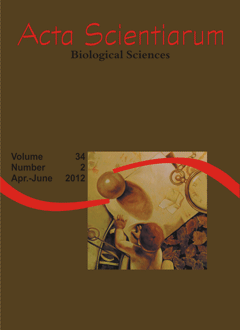<b><i>Austrodiplostomum compactum</i> (Lutz, 1928) (Digenea, Diplostomidae) in the eyes of fishes from Paraná river, Brazil</b> - doi: 10.4025/actascibiolsci.v34i2.9337
Resumo
Parasitological indexes of Austrodiplostomum compactum (Digenea, Diplostomidae) in fishes from the Paraná River, Presidente Epitácio region, state of São Paulo, Brazil, and their relationship with climate and water quality are evaluated. Fifty-one specimens of Plagioscion squamosissimus, 39 Geophagus surinamensis, 27 Hoplias malabaricus and 23 Cichla sp. were collected between June 2007 and June 2008. Water quality and rainfall indexes were measured monthly. P. squamosissimus had the highest parasite rate, with 98% total prevalence, intensity of infection varying between 1 and 255 and parasite mean abundance totaling 40.5 ± 9.9. H. malabaricus had the next parasite rate, with 66.6% total prevalence, parasite intensity between 2 and 184 and mean abundance totaling 22.4 ± 20.9. Cichla sp. had a total prevalence of 52.1%, intensity between 1 and 21, and mean abundance 4.3 ± 2.9. Finally, G. surinamensis had a total prevalence of 46.1%, intensity between 1 and 53 and mean abundance 7.1 ± 8.8. A survey of diplostomid infection in Brazil and the role of piscivore fish as an important host have also been discussed.
Downloads
DECLARAÇÃO DE ORIGINALIDADE E DIREITOS AUTORAIS
Declaro que o presente artigo é original, não tendo sido submetido à publicação em qualquer outro periódico nacional ou internacional, quer seja em parte ou em sua totalidade.
Os direitos autorais pertencem exclusivamente aos autores. Os direitos de licenciamento utilizados pelo periódico é a licença Creative Commons Attribution 4.0 (CC BY 4.0): são permitidos o compartilhamento (cópia e distribuição do material em qualqer meio ou formato) e adaptação (remix, transformação e criação de material a partir do conteúdo assim licenciado para quaisquer fins, inclusive comerciais.
Recomenda-se a leitura desse link para maiores informações sobre o tema: fornecimento de créditos e referências de forma correta, entre outros detalhes cruciais para uso adequado do material licenciado.












1.png)




3.png)













